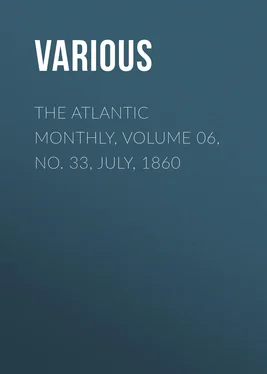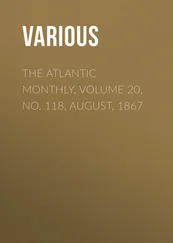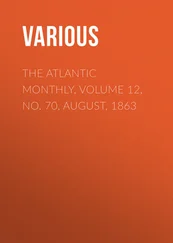Various - The Atlantic Monthly, Volume 06, No. 33, July, 1860
Здесь есть возможность читать онлайн «Various - The Atlantic Monthly, Volume 06, No. 33, July, 1860» — ознакомительный отрывок электронной книги совершенно бесплатно, а после прочтения отрывка купить полную версию. В некоторых случаях можно слушать аудио, скачать через торрент в формате fb2 и присутствует краткое содержание. Жанр: foreign_antique, periodic, foreign_edu, на английском языке. Описание произведения, (предисловие) а так же отзывы посетителей доступны на портале библиотеки ЛибКат.
- Название:The Atlantic Monthly, Volume 06, No. 33, July, 1860
- Автор:
- Жанр:
- Год:неизвестен
- ISBN:нет данных
- Рейтинг книги:4 / 5. Голосов: 1
-
Избранное:Добавить в избранное
- Отзывы:
-
Ваша оценка:
- 80
- 1
- 2
- 3
- 4
- 5
The Atlantic Monthly, Volume 06, No. 33, July, 1860: краткое содержание, описание и аннотация
Предлагаем к чтению аннотацию, описание, краткое содержание или предисловие (зависит от того, что написал сам автор книги «The Atlantic Monthly, Volume 06, No. 33, July, 1860»). Если вы не нашли необходимую информацию о книге — напишите в комментариях, мы постараемся отыскать её.
The Atlantic Monthly, Volume 06, No. 33, July, 1860 — читать онлайн ознакомительный отрывок
Ниже представлен текст книги, разбитый по страницам. Система сохранения места последней прочитанной страницы, позволяет с удобством читать онлайн бесплатно книгу «The Atlantic Monthly, Volume 06, No. 33, July, 1860», без необходимости каждый раз заново искать на чём Вы остановились. Поставьте закладку, и сможете в любой момент перейти на страницу, на которой закончили чтение.
Интервал:
Закладка:
A LEGEND OF MARYLAND
"AN OWRE TRUE TALE."
The framework of modern history is, for the most part, constructed out of the material supplied by national transactions described in official documents and contemporaneous records. Forms of government and their organic changes, the succession of those who have administered them, their legislation, wars, treaties, and the statistics demonstrating their growth or decline,–these are the elements that furnish the outlines of history. They are the dry timbers of a vast old edifice; they impose a dry study upon the antiquary, and are still more dry to his reader.
But that which makes history the richest of philosophies and the most genial pursuit of humanity is the spirit that is breathed into it by the thoughts and feelings of former generations, interpreted in actions and incidents that disclose the passions, motives, and ambition of men, and open to us a view of the actual life of our forefathers. When we can contemplate the people of a past age employed in their own occupations, observe their habits and manners, comprehend their policy and their methods of pursuing it, our imagination is quick to clothe them with the flesh and blood of human brotherhood and to bring them into full sympathy with our individual nature.
History then becomes a world of living figures,–a theatre that presents to us a majestic drama, varied by alternate scenes of the grandest achievements and the most touching episodes of human existence.
In the composing of this drama the author has need to seek his material in many a tangled thicket as well as in many an open field. Facts accidentally encountered, which singly have but little perceptible significance, are sometimes strangely discovered to illustrate incidents long obscured and incapable of explanation. They are like the lost links of a chain, which, being found, supply the means of giving cohesion and completeness to the heretofore useless fragments. The scholar's experience is full of these reunions of illustrative incidents gathered from regions far apart in space, and often in time. The historian's skill is challenged to its highest task in the effort to draw together those tissues of personal and local adventure which, at first without seeming or suspected dependence, prove, when brought into their proper relationship with each other, to be unerring exponents of events of highest concern.
It is pleasant to fall upon the course of one of these currents of adventure,– to follow a solitary rivulet of tradition, such as by chance we now and then find modestly flowing along through the obscure coverts of time, and to be able to trace its progress to the confluence of other streams,–and finally to see it grow, by the aid of these tributaries, to the proportions of an ample river, which waters the domain of authentic history and bears upon its bosom a clear testimony to the life and character of a people.
The following legend furnishes a striking and attractive exemplification of such a growth, in the unfolding of a romantic passage of Maryland history, of which no annalist has ever given more than an ambiguous and meagre hint. It refers to a deed of bloodshed, of which the only trace that was not obliterated from living rumor so long as a century ago was to be found in a vague and misty relic of an old memory of the provincial period of the State. The facts by which I have been enabled to bring it to the full light of an historical incident, it will be seen in the perusal of this narrative, have successively, and by most curious process of development, risen into view through a series of accidental discoveries, which have all combined, with singular coincidence and adaptation, to furnish an unquestionable chapter of Maryland history, altogether worthy of recital for its intrinsic interest, and still more worthy of preservation for the elements it supplies towards a correct estimate of the troubles which beset the career and formed the character and manners of the forefathers of the State.
CHAPTER I.
TALBOT'S CAVE
It is now many years ago,–long before I had reached manhood,–that, through my intimacy with a friend, then venerable for his years and most attractive to me by his store of historical knowledge, I became acquainted with a tradition touching a strange incident that had reference to a mysterious person connected with a locality on the Susquehanna River near Havre de Grace. In that day the tradition was repeated by a few of the oldest inhabitants who dwelt in the region. I dare say it has now entirely run out of all remembrance amongst their descendants, and that I am, perhaps, the only individual in the State who has preserved any traces of the facts to which I allude.
There was, until not long ago, a notable cavern at the foot of a rocky cliff about a mile below the town of Port Deposit. It was of small compass, yet sufficiently spacious to furnish some rude shelter against the weather to one who might seek refuge within its solitary chamber. It opened upon the river just where a small brook comes brattling down the bank, along the base of a hill of some magnitude that yet retains the stately name of Mount Ararat. The visitor of this cavern might approach it by a boat from the river, or by a rugged path along the margin of the brook and across the ledges of the rock. This rough shelter went by the name of Talbot's Cave down to a very recent period, and would still go by that name, if it were yet in existence. But it happened, not many years since, that Port Deposit was awakened to a sudden notion of the value of the granite of the cliff, and, as commerce is a most ruthless contemner of all romance, and never hesitates between a speculation of profit and a speculation of history, Talbot's Cave soon began to figure conspicuously in the Price Current, and in a very little while disappeared, like a witch from the stage, in blasts of sulphur fire and rumbling thunder, under the management of those effective scene-shifters, the quarrymen. A government contract, more potent than the necromancy of the famed wizard Michael Scott, lifted this massive rock from its base, and, flying with it full two hundred miles, buried it fathoms below the surface of the Atlantic, at the Rip Raps, near Hampton Roads; and thus it happens that I cannot vouch the ocular proof of the Cave to certify the legend I am about to relate.
The tradition attached to this spot had nothing but a misty and spectral outline. It was indefinite in the date, uncertain as to persons, mysterious as to the event,–just such a tradition as to whet the edge of one's curiosity and to leave it hopeless of gratification. I may relate it in a few words.
Once upon a time, somewhere between one and two hundred years ago, there was a man by the name of Talbot, a kinsman of Lord Baltimore, who had committed some crime, for which he fled and became an outlaw and was pursued by the authorities of the Province. To escape these, he took refuge in the wilderness on the Susquehanna, where he found this cave, and used it for concealment and defence for some time,–how long, the tradition does not say. This region was then inhabited by a fierce tribe of Indians, who are described on Captain John Smith's map as the "Sasquesahannocks," and who were friendly to the outlaw and supplied him with provisions. To these details was added another, which threw an additional interest over the story,–that Talbot had a pair of beautiful English hawks, such as were most prized in the sport of falconry, and that these were the companions of his exile, and were trained by him to pursue and strike the wild duck that abounded, then as now, on this part of the river; and he thus found amusement to beguile his solitude, as well as sustenance in a luxurious article of food, which is yet the pride of gastronomic science, and the envy of bons vivants throughout this continent.
Читать дальшеИнтервал:
Закладка:
Похожие книги на «The Atlantic Monthly, Volume 06, No. 33, July, 1860»
Представляем Вашему вниманию похожие книги на «The Atlantic Monthly, Volume 06, No. 33, July, 1860» списком для выбора. Мы отобрали схожую по названию и смыслу литературу в надежде предоставить читателям больше вариантов отыскать новые, интересные, ещё непрочитанные произведения.
Обсуждение, отзывы о книге «The Atlantic Monthly, Volume 06, No. 33, July, 1860» и просто собственные мнения читателей. Оставьте ваши комментарии, напишите, что Вы думаете о произведении, его смысле или главных героях. Укажите что конкретно понравилось, а что нет, и почему Вы так считаете.












